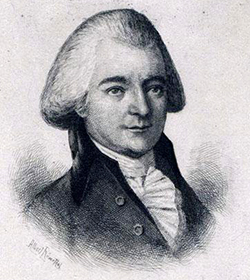1757–4 Mar. 1802

John Sitgreaves, congressman, legislator, and federal judge, was born in England, the son of Thomas, a native of Philadelphia and a resident of New Bern, N.C., and Mrs. John Cady Bryan Sitgreaves. Thomas was a coroner, marshal of the court of admiralty for the port of Beaufort, member of the Anglican church, and supporter of the American cause during the Revolution.
It has been said that young Sitgreaves studied at Eton College in England, but his name does not appear in Richard Arthur Austen-Leigh's Eton College Register, 1753–1790 (1921). He went to New Bern, studied law, and began to practice. On 16 Apr. 1776 he was appointed second lieutenant in the New Bern militia. In 1779 he served on a board of auditors for public and private accounts and claims. At the 1780 Battle of Camden he was aide to Major General Richard Caswell. On returning home he became a commissioner for the sale of confiscated property in the New Bern district. He was assistant clerk of the two sessions of the first state senate in 1777 and clerk of its three sessions in 1778–79 and its two in 1779, but he declined the post in 1781.
As clerk he ordered the preparation of a map of New Bern. Dated 11 Feb. 1779, it was certified by Allen Jones, speaker of the senate, and Thomas Benbury, speaker of the house. This map was "one of the two plans to which the Act passed at the General Assembly held at Halifax Town in January 1779 entitled an Act for the Regulation of the Town of New Bern" refers.
Elected to represent the borough town of New Bern in the first session of the 1784 House of Commons, Sitgreaves was named by that body to the board of trustees of the reorganized New Bern Academy and acted as its secretary. During 1784 and 1785 he attended the Continental Congress. At one of its last meetings in November 1785 he was absent while, by special appointment, holding a term of federal court at Williamsburg, Va.
Again the delegate from New Bern to the state legislature in 1786, 1787, and 1788, he served as speaker during the last two years. At the 1788 state constitutional convention he unsuccessfully supported ratification of the federal Constitution. In New Bern he was noted for his hospitality. William Penn Attmore, a Philadelphia merchant who was in the town to collect debts and who was married to Sitgreaves's sister, Sarah, drew in his journal a diagram showing the seating of guests and the arrangement of food at a dinner in the Sitgreaves home. The last royal governor, Josiah Martin, is said to have taken temporary refuge in a house on a Sitgreaves lot at Broad and Burn streets prior to fleeing the city in May 1775.
In 1789 Sitgreaves was appointed as one of the first trustees for the proposed University of North Carolina. After the admission of North Carolina into the Union on 21 Nov. 1789, a U.S. district court was established at New Bern and Sitgreaves became its attorney. On 20 Dec. 1790, following the death in mid-October of Judge John Stokes, he was appointed by President George Washington, upon recommendation of U.S. Senator Benjamin Hawkins and others, as the district judge of North Carolina, a position he held until his death.
When the president visited New Bern in April 1791, Sitgreaves and Mayor Joseph Leech headed a civic delegation welcoming Washington. After using a room in the former governor's palace as his last office in New Bern, Sitgreaves moved to Halifax, where he died and was buried. The epitaph on the monument over his grave records that he had spent "a life of honor and integrity in the service of his country." From his portrait, an etching was made by Albert Rosenthal of Philadelphia.
Sitgreaves married Mrs. Martha Jones Green (d. 1822), the daughter of General Allen Jones of Northampton County and the widow of James W. Green. Surviving him were a son, John (1799–1868), who married Anne Love, and a daughter, Amaryllis, who married Frederick Lafayette Jones Pride.
Amaryllis Sitgreaves Pride was the namesake of her aunt, Amaryllis Sitgreaves, wife of George Ellis, who represented New Bern in the 1800 and 1801 House of Commons. Arete Ellis, their daughter, a home missionary and teacher at New Bern's free trade school for orphan girls (one of the first schools of its type in the country), is memorialized by large twin stained glass windows in Christ Episcopal Church, New Bern.